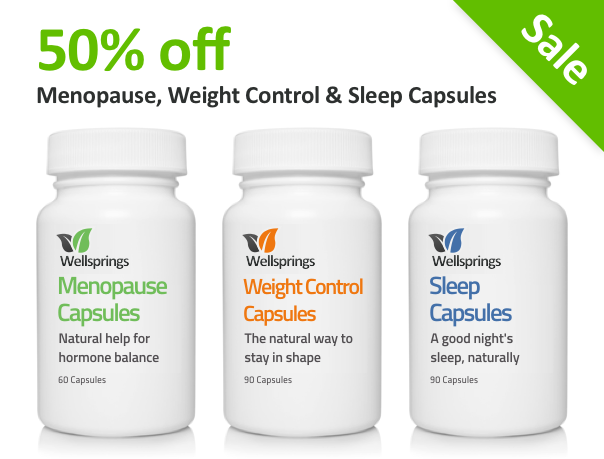How to Help Your Menopause Symptoms
Menopause is all about change, so how can you best manage it?

There are some fortunate women who have no symptoms or only very mild ones, but for the majority of us one or more symptoms in particular can be very troubling and disrupt our lives.
Some women get only one symptom, some get several and some poor souls seem to suffer from all of them. However, don’t despair because help is at hand so keep reading to see how you can best support yourself at Menopause.
Hot flushes
Knowledge is the key here so keep a diary to track what sets them off as it can vary a lot.
Is it caffeine, alcohol, a hot room or anxiety or stress? All are common causes so knowing what sets you off means you start to avoid triggering one.
A simple tip when a flush starts is to take slow, deep breaths, in your nose and out your mouth as being anxious and stress will make it worse.
A dab of bioidentical progesterone cream on the inside of your wrist can also help stop it before it really develops.
Night sweats
At night, these can go on for 3 minutes or more, leaving you drenched in sweat and unable to sleep.
These are a serious symptom that upset so many of your systems – sleep, stress and even blood sugar can be affected.
But there are ways to keep your cool so try switching cozy nightwear for light cotton, and slip a bag of frozen peas into a plastic bag and put under your pillow, and flip the pillow through the night and put your face on the cool side.
Look for specific products designed to keep you cool, choose layers of light blankets over one thick quilt or duvet and use a bedside fan to keep air moving.
Severe symptoms such as night sweats respond best to a combined bioidentical progesterone and oestrogen cream, rather than just progesterone alone.
Sleep issues
Unfortunately, there is plenty to keep you awake up Menopause from night sweats through anxiety and stress – all of which can affect your sleep.
Yoga, tai chi, and meditation can help and any exercise can make a difference — just stop 3 hours before bedtime.
Skip a nightcap, as alcohol will wake you up later and try warm milk instead. It has a substance in it that can help you relax.
Bioidentical progesterone is a natural relaxant and can help you sleep, as can a a natural herbal sleep supplement, but if you are really tossing and turning it doesn’t help to fight it. Get out of bed and read until sleepy.
Vaginal issues
Hormone changes leave the vagina thinner and dryer, which can make sex painful.
There are a few ways to help: the more sex you’re able to have the better the blood flow, which keeps things healthy and there are a number of water-based vaginal lubricants or vaginal moisturisers.
A combination bioidentical cream with oestrogen can also help, and if you actually have more severe dryness or atrophy, then you will certainly need additional oestrogen such as Wellsprings oestrogen cream and you can use bioidentical progesterone alongside to provide hormone balance.
Lost libido
This again seems to become more frequent at Menopause and there is no immediate or short-term solution.
However, the first thing to do is actually make more time for sex and try using more massage and foreplay, too.
Hormone changes are a main cause, and progesterone is the key hormone behind sex drive in women so if you are low that will be having an effect.
Other things that diminish your sex drive can strike at the same time such as tiredness, poor sleep, bladder trouble, feeling anxious, depressed or stressed and relationship issues can play a part too.
Mood swings
This might take you back to your pre-menopause days if you suffered from conditions such as PMS, it will seem horribly familiar.
Unfortunately if you had bad PMS, the hormonal changes that happen during this time may cause even bigger mood swings.
You may experience sudden unexpected bouts of crying, being angry, more sad than usual or even more happy than usual but whatever it is it seems more extreme.
Yoga and tai chi can help here, too as can sharing good times with friends or family.
Your doctor is likely to suggest a low-dose birth control pill or antidepressants, but there are a number of natural alternatives.
Bioidentical progesterone is an option as it is a natural relaxant to help you cope with such mood changes.
Headaches
Migraines can get worse at or around the time of menopause, or show up for the first time.
Again a good technique to help yourself is to keep a diary to see what seems to trigger them and if they show up along with hot flushes as that way you can take steps to lessen them.
Eating small meals through the day can help if hunger is a headache trigger and a change in your sleep schedule may also be a trigger, so try to keep to the same schedule every night.
Hair loss or gain
Hair can thin or shed faster around the time of menopause., but at the same time, it may show up where you don’t want it and that’s on your chin and cheeks.
To save what you have treat it gently by avoiding too much sun, which is drying, and switch to colouring products that don’t have harsh chemicals.
With unwanted facial hair, that often indicates a rise in testosterone, so check your hormone balance and seek professional advice on how to get rid of it.
Spots
You expect to have acne in your teens but not in your 50s but it’s common around menopause, too.
Make sure your moisturiser, sunscreen, cleanser, and other facial products are gentle.
Become a committed label reader and look for the words oil free, won’t clog pores, noncomedogenic, and non-acnegenic. Even tough cases can clear with time and may need a doctor’s help if serious.
Mental fog
“Use it or lose it” really can help you fight fuzzy thinking and stay focused during menopause.
Challenge your brain by learning something new, like a hobby or language, or a daily crossword or jigsaw puzzle can help too.
Low progesterone levels are linked to brain flog so making sure you have sufficient is a good start.
Lowering your stress levels can also help as well because women with more hot flushes – which can be linked to stress – say they have more memory troubles.
Post menopause
You would hope that by this point your hormonal symptoms would be over, and for the majority of women they can be.
However if you still have conditions such as osteoporosis or vaginal atrophy these still require reasonable hormone balance to ensure these conditions are controlled.
If you are post Menopause and looking simply to maintain your hormone levels without any severe symptoms then a specific cream – Lifelong – has been designed to help with this.
Post Menopause the symptoms are more often related to anxiety and stress rather than hormonal surges so this combination of progesterone, oestrogen and vitamins can help keep you on an even keel.
Helpful information
These are certainly the main symptoms that women can experience, but of course it does not mean you will experience all of them or even some of them.
Hormone balance is often linked to many of these symptoms, and if you are not sure which hormone or hormones you may need to supplement then this article will be helpful.
https://anna.blog.wellsprings-health.com/which-hormone-or-hormones-might-you-need/

















